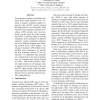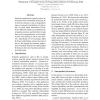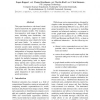ACL
2015
8 years 7 months ago
2015
We present and evaluate a method for automatically detecting sentence fragments in English texts written by non-native speakers. Our method combines syntactic parse tree patterns ...
ACL
2015
8 years 7 months ago
2015
It has been extensively observed that languages minimise the distance between two related words. Dependency length minimisation effects are explained as a means to reduce memory l...
ACL
2015
8 years 7 months ago
2015
In this paper, we introduce Long ShortTerm Memory (LSTM) recurrent network for twitter sentiment prediction. With the help of gates and constant error carousels in the memory bloc...
ACL
2015
8 years 7 months ago
2015
Downstream processing of machine translation (MT) output promises to be a solution to improve translation quality, especially when the MT system’s internal decoding process is n...
ACL
2015
8 years 7 months ago
2015
We present a three-pronged approach to improving Statistical Machine Translation (SMT), building on recent success in the application of neural networks to SMT. First, we propose ...
ACL
2015
8 years 7 months ago
2015
Semantic applications typically extract information from intermediate structures derived from sentences, such as dependency parse or semantic role labeling. In this paper, we stud...
ACL
2015
8 years 7 months ago
2015
We present cort, a modular toolkit for devising, implementing, comparing and analyzing approaches to coreference resolution. The toolkit allows for a unified representation of po...
ACL
2015
8 years 7 months ago
2015
This paper introduces a web-based visualization framework for graph-based distributional semantic models. The visualization supports a wide range of data structures, including ter...
ACL
2015
8 years 7 months ago
2015
We present a new factoid-annotated dataset for evaluating content models for scientific survey article generation containing 3,425 sentences from 7 topics in natural language pro...
ACL
2015
8 years 7 months ago
2015



